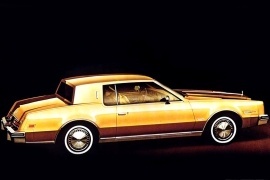
OLDSMOBILE Toronado
Generations Timeline, Specs and Pictures

Toronado’s final generation was produced between 1986 and 1992.
Completely redesigned, the new vehicle had adopted some of the features that aided in the first Toronado’s popularity increase, such as hidden headlights, a trait also previously shared by some Dodge Charger models. Engine range was reduced to 3.8 L V6 and transmission was upgraded to a 4-speed automatic. The vehicle was shrunk was more and the interior gained some extra luxury touches like new upholstery available with a choice of cloth or leather. No matter the changes made, The Toronado could not be saved from sales decline and production ceased in 1992.

The third Toronado generation saw a series of adjustments that drove the vehicle even farther from the initial 1966 look.
Wheelbase and length were shortened while the engine line was broadened with a few units, one of which was a terribly unhappy choice. The Oldsmobile V8’s were joined by a Buick-sourced V6 which became highly unpopular with customers. In attempt to turn around the public’s perception, the V6 was converted to a Diesel version whose reception was even worse. Despite this small setback, the Toronado was improved by a series of other features that included the introduction of rear suspension and luxury touches.

The second generation of the Oldsmobile Toronado was introduced in 1971, at the dusk of the muscle-car era.
It was marketed as a personal luxury coupe.
At the beginning of the ’70s, most of the cars on the market were still rear-wheel-drive and it was considered the only way to put more torque to the ground. The Oldsmobile thought another way: the front-wheel-drive solution will be the future, and they were right. So, they built the Toronado on a new platform and sent all the power to the front wheels.
Long, wide, and with edges on the fenders and slightly sculptured door panels, the Toronado was an all-American GT cruiser. It wasn’t built for fast, curved roads, but for long and comfortable trips. The front featured four round headlights covered with a lid when the lights were off. In the back, the Toronado introduced a new set of taillights, used for braking and as a turn-signal. That system became standard afterward for most of the American cars.
Inside, there was a wide bench in the front where three people could sit in comfort. The dashboard was built around the driver. The instrument cluster featured a square dial for the speedometer and an AM/FM-8 Track stereo on the center stack. The gear-selector was mounted on the steering column. The car featured power-windows, power-locks, air-conditioning, and ABS for the rear axle. For the rear passengers, the Toronado offered a wide bench as well.
Under the hood, the big coupe was offered with a 7.5-liter V8 unit mated to a standard 3-speed gearbox. Despite its big displacement, the engine offered just 270 hp, which was not that much for a 2-ton vehicle.

Contrary to general belief, Toronado’s appearance is actually linked to series of fortunate events rather than of extensive research and styling.
The original concept originated as 1962 sketch signed by Oldsmobile designer David North. Although North’s daring design was never intended for production, GM management caught sight of the drawing and allowed Oldmobile to start building the vehicle within weeks. The first generation vehicle (1966-1970) came equipped with two versions of the powerful V8 Rocket gasoline unit that propelled the car from 0 to 60 in less than 8 seconds despite Toronado’s average 5,000 lbs weight.























































